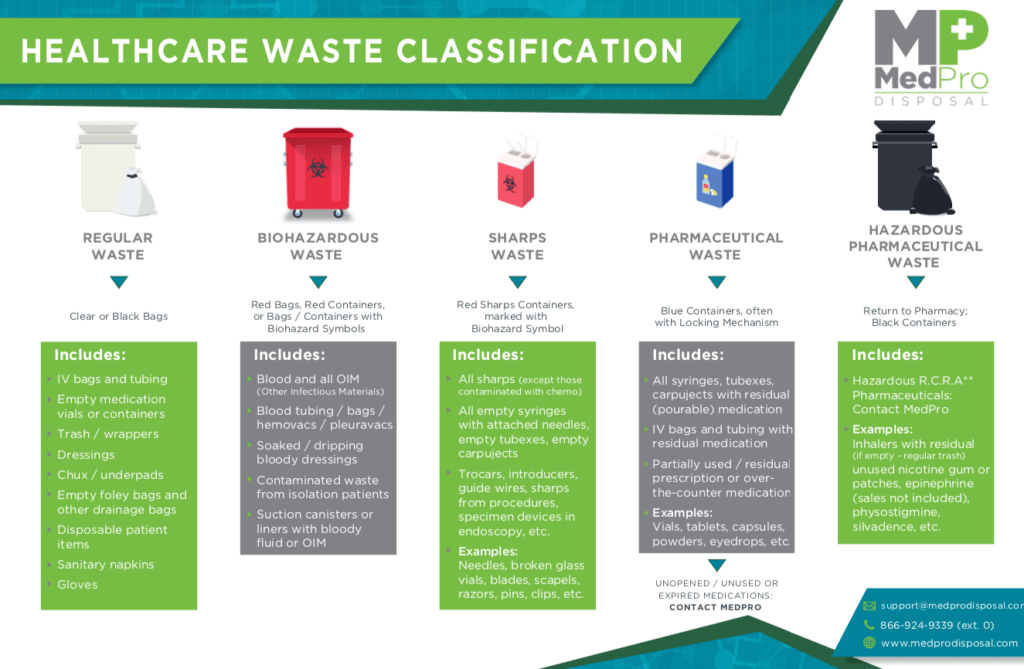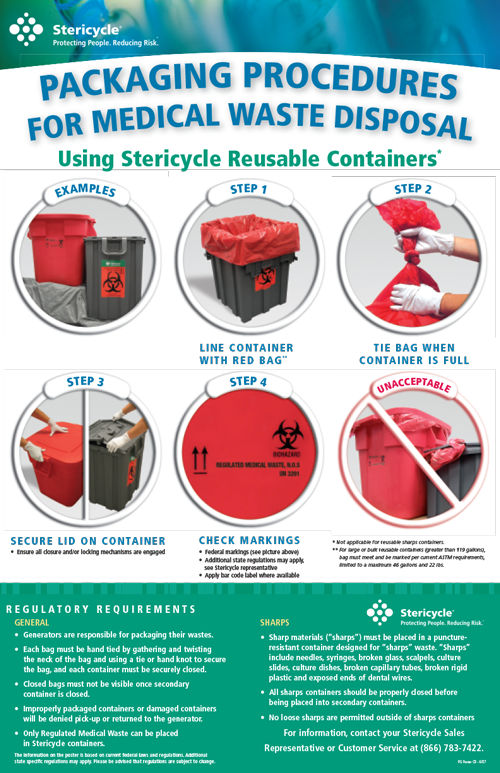Compliant and Reliable Medical Waste Removal Service: Partnering for a Cleaner Future
Conformity and Regulations for Medical Garbage Disposal
Conformity and policies for clinical waste disposal play a crucial duty in guaranteeing the safety and health of both healthcare specialists and the basic public. Proper monitoring of medical waste is important to protect against the spread of infections, safeguard the setting, and preserve public health and wellness. This requires adherence to specific guidelines and methods stated by regulatory firms and bodies. These regulations incorporate various elements, consisting of the classification and partition of medical waste, correct storage and taking care of procedures, along with transportation and disposal techniques. By adhering to these policies, medical care facilities can lessen the threat of contamination and potential injury to people and the atmosphere. This post will explore the relevance of compliance and offer a review of the essential guidelines controling medical waste disposal.
Value of Conformity
The value of conformity with guidelines for clinical garbage disposal can not be overemphasized. Appropriate disposal of clinical waste is vital for guaranteeing the security and wellness of healthcare workers, patients, and the general public. Medical waste, which includes things such as made use of needles, infected gloves, and biomedical waste, can pose serious health risks otherwise taken care of and disposed of properly.
Conformity with policies ensures that clinical waste is taken care of in a method that reduces the potential for direct exposure to hazardous materials and contagious diseases - medical waste removal service. It assists avoid the spread of infections, such as HIV, hepatitis B and C, and various other bloodborne virus. Compliance additionally plays a crucial role in shielding the atmosphere by avoiding contamination of water resources, soil, and air
Failing to follow laws can result in extreme repercussions for healthcare centers, including penalties, legal activity, and damage to their online reputation. Furthermore, non-compliance may jeopardize the health and safety and security of healthcare employees, patients, and the area.
Compliance with laws for clinical garbage disposal requires adherence to particular guidelines and procedures. These may include correct segregation, product packaging, labeling, and storage space of medical waste. It likewise entails using authorized disposal approaches, such as autoclaving, landfilling, or incineration, relying on the type of waste.
Governing Agencies and Bodies
Regulatory agencies and bodies play a critical role in supervising compliance with guidelines for clinical garbage disposal. These organizations are in charge of setting requirements, standards, and methods to make sure the secure and correct handling of clinical waste. They keep track of and implement compliance to safeguard public health and wellness and the atmosphere.
One of the most popular regulatory agencies in the United States is the Epa (EPA) The EPA is in charge of regulating the storage space, transportation, therapy, and disposal of clinical waste. They develop standards for waste generators, carriers, and therapy facilities to follow, guaranteeing that all necessary precautions are required to avoid the spread of illness and contamination.
One more important regulatory body is the Occupational Safety And Security and Health And Wellness Administration (OSHA) OSHA sets policies and requirements to protect employees from job-related dangers, including those related to clinical waste. WasteX Medical Waste Disposal. They give guidelines for the safe handling and disposal of clinical waste to safeguard staff members in health care centers
In addition to these government agencies, specific states also have their very own regulatory bodies that look after medical garbage disposal. These agencies may have their very own particular laws and requirements that need to be followed.

Category and Segregation of Medical Waste
To make certain proper administration of medical waste, it is vital to categorize and segregate it according to developed protocols and standards. medical waste disposal. Classification and partition play a crucial role in reducing the risk of infection, safeguarding the setting, and guaranteeing the security of medical care employees and the general public
Medical waste is identified right into various categories based on its prospective danger degree. These groups consist of infectious waste, pathological waste, sharps waste, pharmaceutical waste, chemical waste, and radioactive waste. Each classification needs certain handling, transportation, disposal, and storage methods to lessen the threat of direct exposure and contamination.
Partition of clinical waste entails dividing various kinds of waste at the resource. This procedure makes certain that waste with various danger levels is not mixed, reducing the potential for cross-contamination and making disposal procedures more reliable. Correct WasteX Medical Waste Disposal partition is attained with making use of color-coded containers and tags, which aid medical care workers and waste administration personnel take care of each kind and determine of waste appropriately.
In enhancement to category and segregation, healthcare centers have to likewise abide by local, state, and government laws relating to clinical waste monitoring. These guidelines detail details demands for storage space, transportation, treatment, and last disposal of clinical waste, guaranteeing compliance and maintaining public wellness and security.
Proper Storage Space and Managing Procedures
Correct storage space and dealing with procedures play a vital role in ensuring the compliant and secure monitoring of medical waste. Medical waste, which consists of items such as made use of syringes, polluted gloves, and ran out medicines, can position serious wellness and environmental risks otherwise dealt with appropriately. As a result, it is vital for healthcare centers and other generators of medical waste to carry out strict storage space and dealing with methods.
To start with, clinical waste must be stored in sturdy, leak-proof containers that are especially created for this purpose. These containers must be identified with the universal biohazard icon and words "medical waste" to plainly indicate the contents. Furthermore, the containers must be kept safely closed to stop any prospective leak or splilling.
Additionally, it is essential to segregate different sorts of clinical waste to prevent cross-contamination. Sharps, such as scalpels and needles, ought to be kept in puncture-resistant containers to decrease the risk of injuries - WasteX Medical Waste Disposal. Chemical waste, such as disinfectants and solvents, must be saved separately from other sorts of medical waste to avoid dangerous exposures or chemical reactions

Transport and Disposal Techniques
Health care facilities should guarantee the safe transport and correct disposal of their clinical waste to abide by guidelines and shield public wellness. Transport and disposal approaches play an essential role in preventing the spread of transmittable illness and decreasing the ecological impact of clinical waste.
To move medical waste, healthcare centers must utilize puncture-resistant and watertight containers that are labeled with the biohazard symbol. These containers need to be securely secured to stop any kind of leakage throughout transport. Furthermore, healthcare centers ought to establish protocols for the transportation procedure, consisting of the usage of qualified employees and devoted vehicles.
When the clinical waste gets to the disposal facility, it undertakes numerous methods of treatment - WasteX Medical Waste Disposal. One usual approach is incineration, which involves burning the waste at high temperatures to ruin microorganisms and lower the volume of waste.
It is necessary for medical care facilities to collaborate with accredited and allowed waste management companies to ensure proper transportation and disposal of clinical waste. These business have the proficiency and resources to deal with medical waste safely and in conformity with guidelines.
Verdict
In verdict, compliance with laws for medical waste disposal is of utmost significance to make certain public health and wellness and safety. In general, adherence to compliance and regulations is essential to properly manage clinical waste.
Medical waste, which consists of items such as utilized needles, infected gloves, and biomedical waste, can posture major wellness risks if not taken care of and disposed of correctly.
These groups include contagious waste, pathological waste, sharps waste, pharmaceutical waste, chemical waste, and contaminated waste.Segregation of medical waste entails separating various kinds of waste at the source. Appropriate partition is attained through the usage of color-coded labels and containers, which assist medical care workers and waste monitoring employees deal with each kind and recognize of waste correctly.
Chemical waste, such as solvents and anti-bacterials, need to be stored independently from various other types of medical waste to prevent dangerous direct exposures or chemical responses.